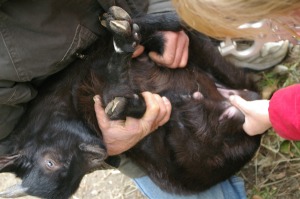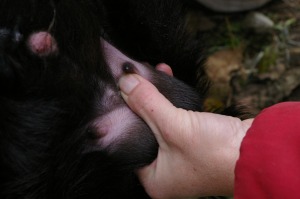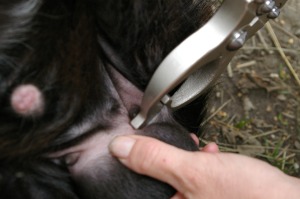Well, the inevitable has happened. It was a dry summer, so not many berries around for our ursine co-inhabitants here in this remote rainforest valley. In addition, the fish runs were down. Then last weekend we had our fifty-year flash flood, which swept away both fish and berries, and blurred the notional “boundary lines” which the officials fondly imagine keep humans from bears/cougars and keep the peace. For the last month there have been intimations that those boundaries were about as effective as Chamberlain’s piece of paper in 1939: neighbours reported seeing a grizzly bear routinely ambling around my property; my husband (who is tending the farm while we decide what to do with it and our lives) eventually saw him/her sitting thirty meters from my house, across the grass and orchard, behind the two boundary fences, calmly surveying the pickings. The next night he made his move and broke the main branches on my two pear trees and apple trees. David reported the attack to the RAPP centre in Kamloops and also crosses the road to the Ministry of Earth and Water, where a generous parks official lent me an electric fence, which friends and he set up encircling the orchard; meanwhile we picked almost all the remaining fruit. He thought about ringing our year old $22 000 chicken barn instead, but felt it was as solid as a building could be.
Two weeks later he heard that at least two neighbours down the highway had their chicken houses ransacked and lost their entire flocks. Then the floods hit, and everyone was preoccupied with surviving, then with trying to save their possessions, cars, houses, fences, bridges, stock, food. That same night one of my egg customers phoned to warn about these attacks and offered the use of her gun; frankly, she said, she wanted to protect her food supply.
David decided to move the electric fence, but was suffering a back injury and decided to postpone it until the weekend and some more healing had first taken place. Meanwhile he increased the lights and radios around the chicken house, and stowed away and secured the bags of feed even more securely behind at least two four inch thick doors.
The following night around 11 pm he heard the scream of a hen. There was a new moon so it was black outside, but from my house he could see an illuminated side of the chicken shed about two metres away and he could see no commotion. He could only guess that the bear had entered from the side, the weakest side of course. Without a dog or gun, surrounded by neighbours, with the flooded slough still saturating the ground all around, he could do little besides yell “shoo bear!” and bang some pots and pans. Later that night he heard more shrieks, but at dawn my restless fears were allayed when he heard the familiar cock crow. Unlike Peter, he felt relieved of his guilt–until he dressed and went down to let them out to free range, and discovered the side door ripped open, and a line of carcasses stretching through the broken page wire fence and under the trees towards the neighbour’s lawn. Inside, the remainder of my flock were traumatised, the biggest rooster hobbling about with one wing extended, a claw puncture mark on his back. There was even one dead chicken, otherwise untouched, inside the hen house.
He reported the attack to Kamloops (a mere 743 kms drive away) and was contacted at work later that day by our Conservation Officer who by good fortune had just made it back into the valley that day. They rendezvoused at 6 pm and David showed him the wooden barricade had erected overt the broken door. The CO laughed and said a grizzly would toss that side with his little ginger, literally.
“That’s what I feared,” Davie confessed, “but I have no other defence save the electric fence. And that seems so puny.”
“Actually that’s the best defence,” he said. They tracked the bear scat and chicken bodies across my neighbour’s property and back into the bush which stretches a hundred meters to the highway. He didn’t want to go any further.
“So,” David quite rightly asked, “since you’re staying nearby, when I see the bear tonight I’ll phone you and you can come and shoot it?”
“I wish I could, but no,” he sighed again. “If the fence is broken, then I can.”
“So twenty carcasses, a ravaged chicken house and a loss of livelihood aren’t enough.”
“You got it. Ministry policy. I must obey. If he attacks your goats, on the other hand, then I can shoot.”
“Who makes these rules?”
Apparently, he shrugged with–what I hope was–embarrassment and turned away.
David spent the next three hours and into the darkness moving the electric fence to surround my chicken house. My remaining flock reluctantly returned to the scene of the crime except for one canny rooster which, for a time, tried to roost in a nearby tree. David left them to the tender mercies of the night, the barricaded door and turned on the electric current, and hoped for the best.
That was last night. At dawn they were all still safe, but the biggest rooster was barely dragging himself around. David did, however, find bear scat outside my living room window on the grass and in front of the goat gate ten meters across from my house. He noticed the wooden superstructure above the five foot log railing fence (which I had erected to dissuade the goats from jumping out) had been broken down. I have seven pygmy goats now, and five get moved every night out of their pen and into their locked quarters in the nearby barn; the two grown boys like to take their chances in their run. They were safe, but I wonder for how long. Part of me dreads going out tomorrow morning and finding two goat carcasses by the fence; the other part looks forward to it so that then I will have reason to get the CO to shoot the grizzly.
Or maybe I should work with the current capitalist regime, move back to the farm, and put a sign at my gate saying: “BEAR VIEWING STATION: see the grizzly at close quarters as it kills chickens, smashes fruit trees and rips apart pygmy goats–LIVE! P.S.: Since my livelihood is being destroyed in front of your eyes, donations gratefully accepted.”































